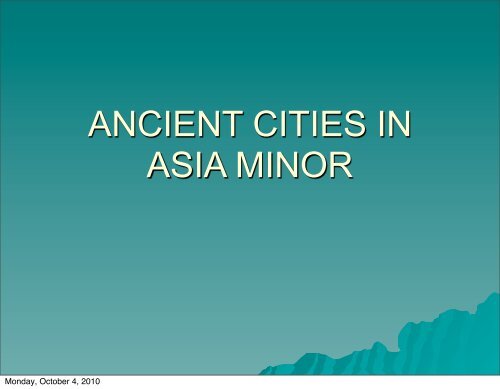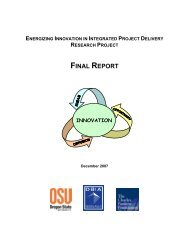ANCIENT CITIES IN ASIA MINOR - SPUR
ANCIENT CITIES IN ASIA MINOR - SPUR
ANCIENT CITIES IN ASIA MINOR - SPUR
You also want an ePaper? Increase the reach of your titles
YUMPU automatically turns print PDFs into web optimized ePapers that Google loves.
Monday, October 4, 2010<br />
<strong>ANCIENT</strong> <strong>CITIES</strong> <strong>IN</strong><br />
<strong>ASIA</strong> M<strong>IN</strong>OR
Different cultures<br />
Different regions<br />
Different times 3000BC -1400AD<br />
Monday, October 4, 2010
Monday, October 4, 2010<br />
Map of Asia Minor<br />
Troy<br />
Pergamon<br />
Perge<br />
Hattusas<br />
Cappadocia<br />
Sultan Hani
Geographic region<br />
Site description<br />
People and history<br />
City building elements<br />
Monday, October 4, 2010
Monday, October 4, 2010<br />
Map of Asia Minor<br />
Troy<br />
Pergamon<br />
Perge<br />
Hattusas<br />
Cappadocia<br />
Sultan Hani
Monday, October 4, 2010
Monday, October 4, 2010<br />
Mound 600ft. x 450 ft. in area, 30’ high<br />
10 layers, 4400 years of occupation
Monday, October 4, 2010
Monday, October 4, 2010<br />
Troy VI in addition to fortification wall ditch 12’wide 6’ deep hewn into bed rock
Monday, October 4, 2010<br />
Ramp to palace over wall of
Monday, October 4, 2010<br />
Ramp to palace over wall of Troy II
Monday, October 4, 2010<br />
Megaron houses Troy II
Troy VI eastern wall and<br />
gate<br />
Monday, October 4, 2010
Monday, October 4, 2010<br />
West Sanctuary Troy VIII; Roman wells
Monday, October 4, 2010<br />
Large theater Troy IX
Monday, October 4, 2010<br />
Odeion Troy IX
Monday, October 4, 2010<br />
Roman Odeion Troy IX
Monday, October 4, 2010<br />
Troy<br />
II<br />
III<br />
IV<br />
VI
Monday, October 4, 2010<br />
Troy looking north
Monday, October 4, 2010<br />
Map of Asia Minor<br />
Troy<br />
Pergamon<br />
Perge<br />
Hattusas<br />
Cappadocia<br />
Sultan Hani
Oldest city 2500 BC Hatti people<br />
Destroyed by Hittites 1750 BC<br />
Rebuilt 1650 BC as Hittite capital<br />
Existing remnants from 1250 BC<br />
About 1200 BC destroyed by war/fire<br />
Monday, October 4, 2010
Monday, October 4, 2010<br />
Hattusa 700 ft.E-W, 1200 ft. N-S extension; large temple
Monday, October 4, 2010
Monday, October 4, 2010
Monday, October 4, 2010
Monday, October 4, 2010<br />
Royal fortress within but 900 ft. above the rest of the city
Monday, October 4, 2010<br />
Fortifications: length of wall 4 mi. 25’ high, w/5 gates 15’high, square towers
Monday, October 4, 2010
Monday, October 4, 2010
Monday, October 4, 2010
Monday, October 4, 2010<br />
Earth berm 750 ft. long at base 240 ft. wide
Monday, October 4, 2010
Monday, October 4, 2010
Monday, October 4, 2010<br />
Yalizikaya Rock Sanctuary; Temple area w/gate and courtyard
Monday, October 4, 2010
Monday, October 4, 2010
Monday, October 4, 2010
Monday, October 4, 2010<br />
God Scharumma with King Tuthalija IV
Monday, October 4, 2010
Monday, October 4, 2010
Monday, October 4, 2010<br />
Map of Asia Minor<br />
Troy<br />
Pergamon<br />
Perge<br />
Hattusas<br />
Cappadocia<br />
Sultan Hani
Hellenistic period from death of Alexander the Great in<br />
323BC to 27BC, Augustus Roman Emperor<br />
Hellenistic Culture: blending of Greek language and style<br />
with indigenous cultures conquered by Alexander<br />
Hellenistic city planning, in contrast to classic times,<br />
more deliberately planned, implemented over shorter<br />
periods of time, serving the glorification of the ruler. In<br />
case of new city foundations laid out with orthogonal grid<br />
system according to Hippodamus<br />
Lysimachos, one of Alexander’s generals, pronounced<br />
himself king over his part of the empire and made<br />
Pergamon his capital; science and arts flourished; library;<br />
parchment replaced papyrus<br />
Monday, October 4, 2010
Monday, October 4, 2010
Monday, October 4, 2010
Monday, October 4, 2010
Monday, October 4, 2010
Monday, October 4, 2010
Monday, October 4, 2010
Monday, October 4, 2010
Monday, October 4, 2010
Cult of Asclepius brought here from Epidaurus in 4.C.BC<br />
The Asklepeion flourished in Hellenistic /Roman times<br />
Existing remnants from Emperor Hadrian’s time (1.C.AD)<br />
Monday, October 4, 2010
Monday, October 4, 2010
Monday, October 4, 2010
Monday, October 4, 2010
Monday, October 4, 2010
Monday, October 4, 2010
Monday, October 4, 2010
Diagnosis dream interpretation<br />
Treatment of body psyche mind spirit<br />
sleep herbal therapy massage baths mud packs drinking<br />
water<br />
music theater<br />
Monday, October 4, 2010
Monday, October 4, 2010<br />
Map of Asia Minor<br />
Troy<br />
Pergamon<br />
Perge<br />
Hattusas<br />
Cappadocia<br />
Sultan Hani
Roman city planning: new materials,<br />
techniques: Roman arch, cupola, dome, barrel<br />
vault, colonnades; grand ornate buildings,<br />
engineering solutions<br />
Perge flourished in the 1./2.C.AD; Pax Romana<br />
27BC – 180AD<br />
Plancia Magna,lived 2.C.AD, city’s highest<br />
administrator, priestess of Diana, sponsored<br />
several public buildings<br />
Monday, October 4, 2010
Monday, October 4, 2010
Monday, October 4, 2010
Monday, October 4, 2010
Monday, October 4, 2010
Monday, October 4, 2010
Monday, October 4, 2010
Monday, October 4, 2010
Monday, October 4, 2010
Monday, October 4, 2010
Monday, October 4, 2010<br />
Map of Asia Minor<br />
Troy<br />
Pergamon<br />
Perge<br />
Hattusas<br />
Cappadocia<br />
Sultan Hani
Monday, October 4, 2010
Monday, October 4, 2010
Monday, October 4, 2010
Monday, October 4, 2010
Monday, October 4, 2010
Monday, October 4, 2010
Underground cities origin unclear; recorded<br />
history Xenophon 4.C. BC; 155 found to date;<br />
served as refuge during Persian (605 AD); Arab<br />
Muslim invasions (647AD)<br />
Monastic communities 2.C. AD Christians<br />
pursuing ascetic life style;<br />
6.C. AD monasteries, churches/chapels<br />
Rock cut villages<br />
Monday, October 4, 2010
Monday, October 4, 2010
Monday, October 4, 2010
Monday, October 4, 2010
Monday, October 4, 2010
Monday, October 4, 2010
Monday, October 4, 2010
Monday, October 4, 2010
Monday, October 4, 2010<br />
Map of Asia Minor<br />
Troy<br />
Pergamon<br />
Perge<br />
Hattusas<br />
Cappadocia<br />
Sultan Hani
End of 12.C.AD Seljuk Sultan agreement with Venetians<br />
Allow to move their trade goods through his realm<br />
Build safe overnight accommodations along the ancient trade routes in one<br />
day’s caravan travel distance<br />
Repair roads and bridges<br />
Against a fee<br />
76 caravansaries were constructed<br />
Seljuk architects devised a unique architectural prototype: courtyard building<br />
with attached great hall<br />
Sultan Hani: open courtyard 75’x150’. Building contains sleeping quarters,<br />
dining room, kitchen, bath, stables, storage space, repair shops, money<br />
exchange, place for worship<br />
Monday, October 4, 2010
Monday, October 4, 2010
Monday, October 4, 2010
Monday, October 4, 2010
Monday, October 4, 2010
Monday, October 4, 2010
Monday, October 4, 2010
Monday, October 4, 2010
Monday, October 4, 2010
Monday, October 4, 2010
Monday, October 4, 2010




